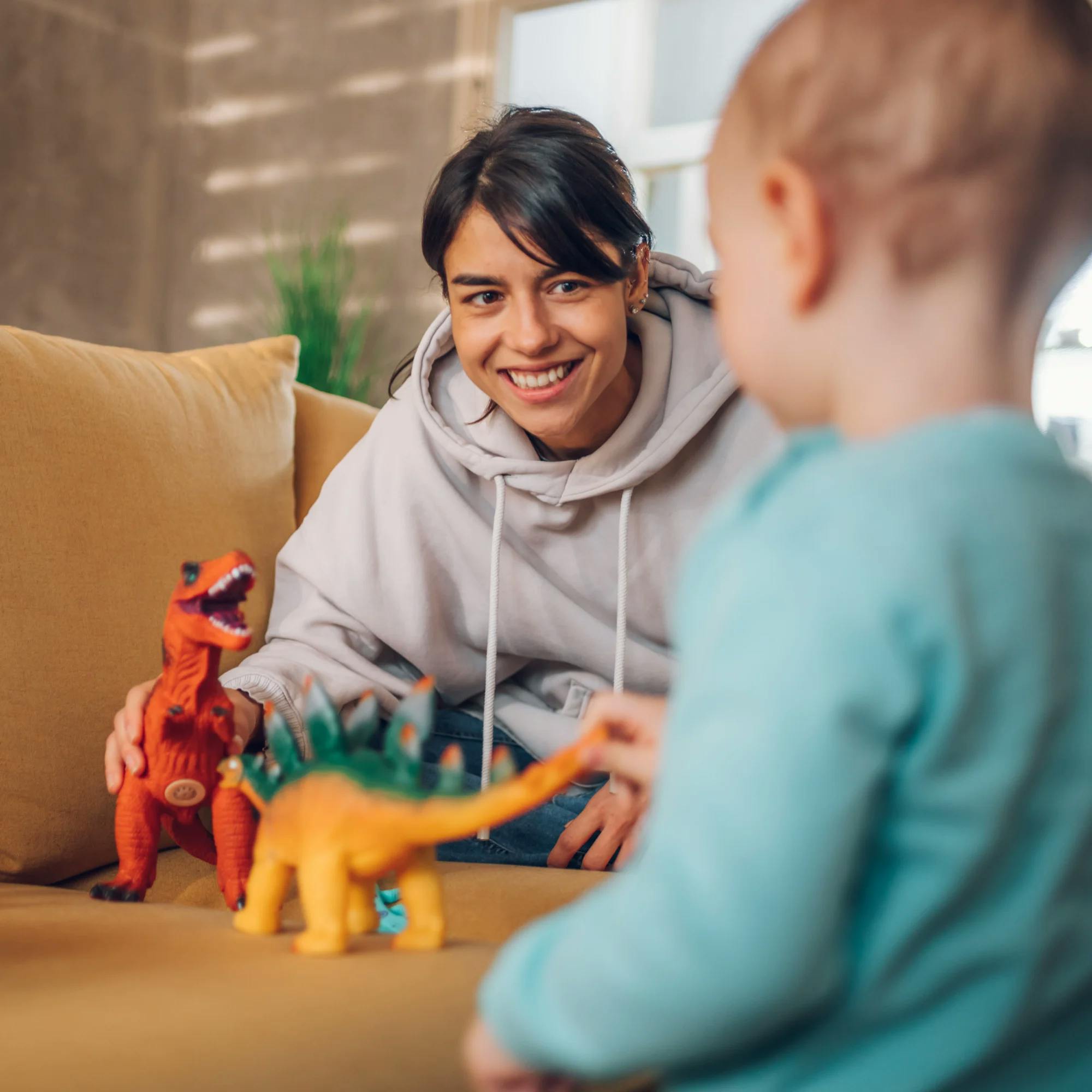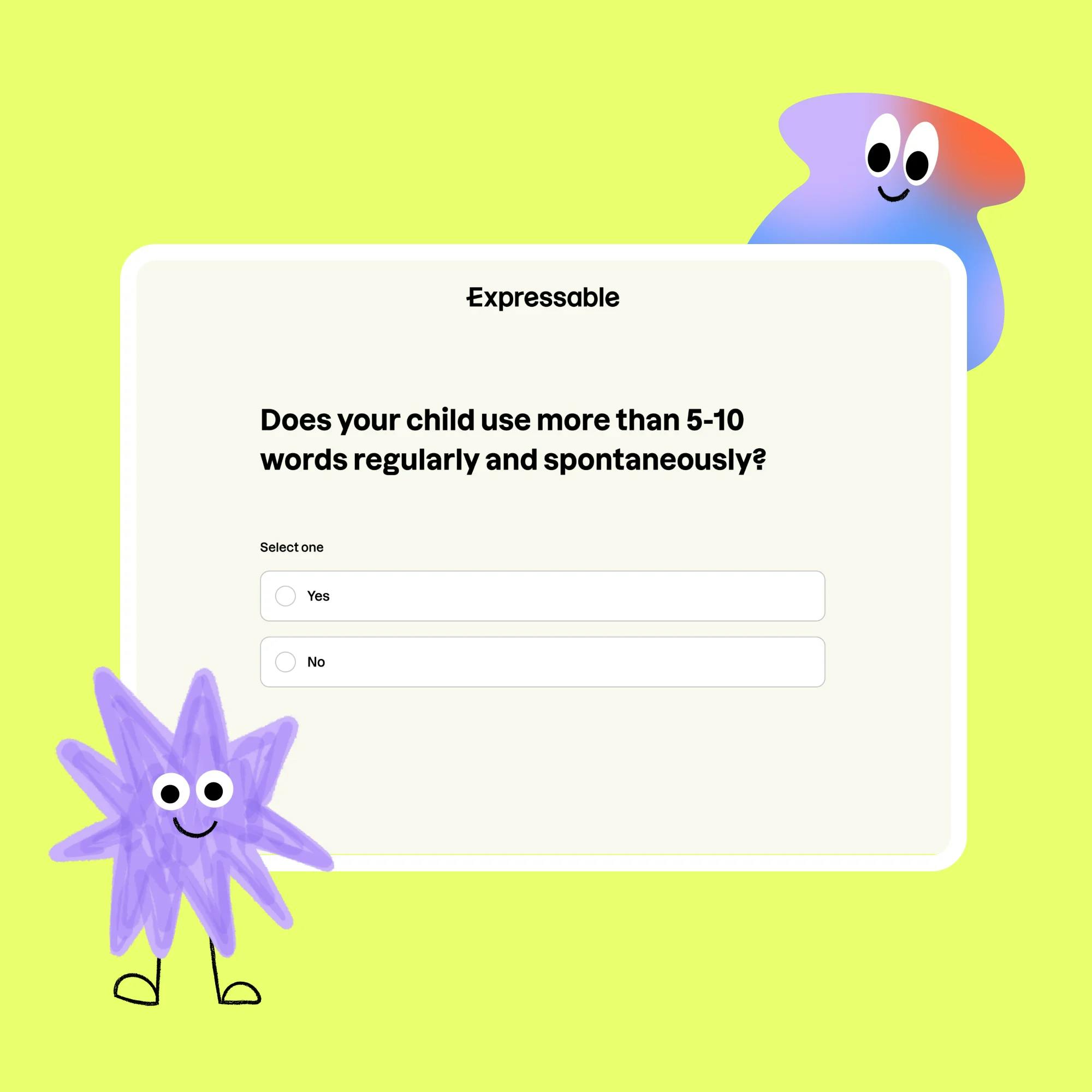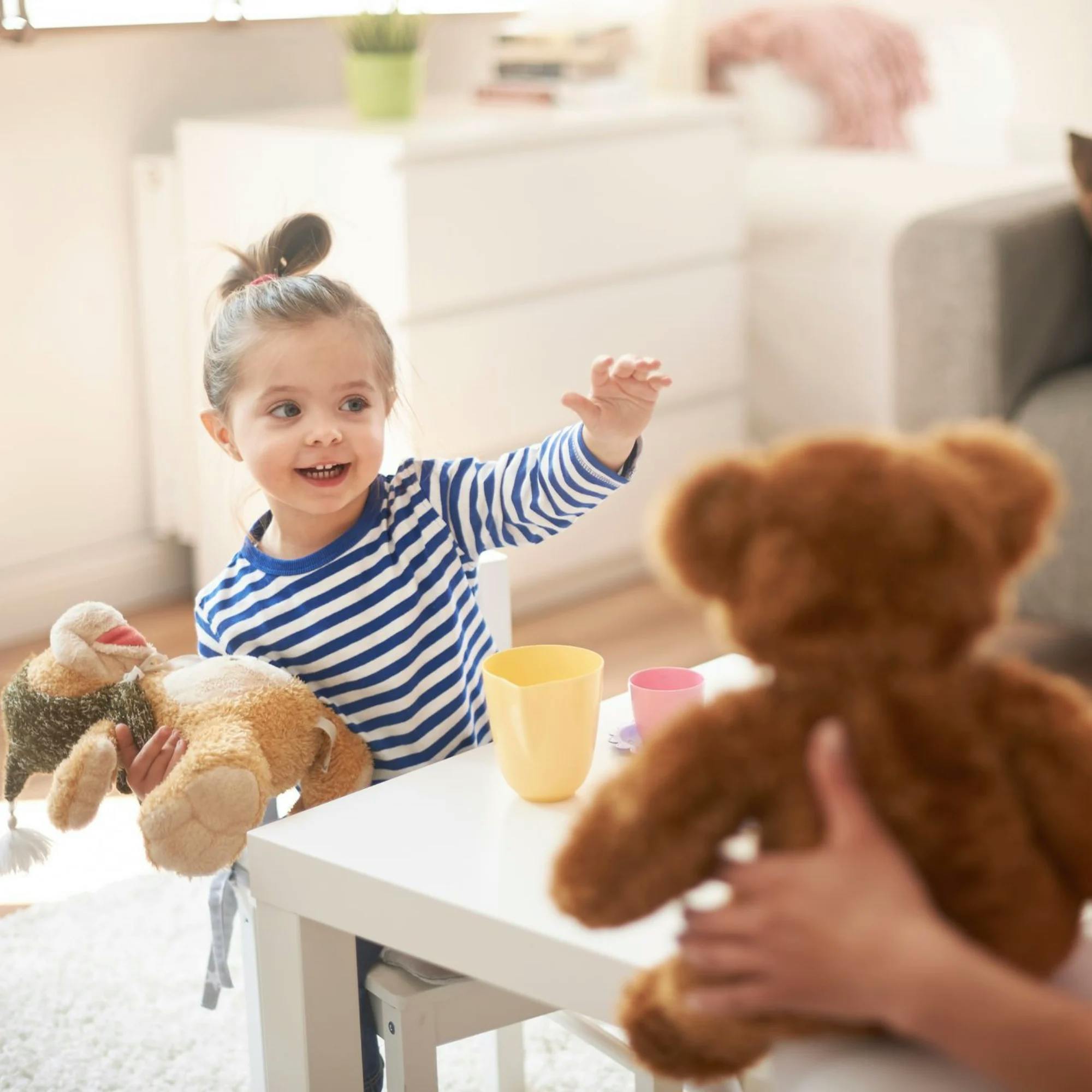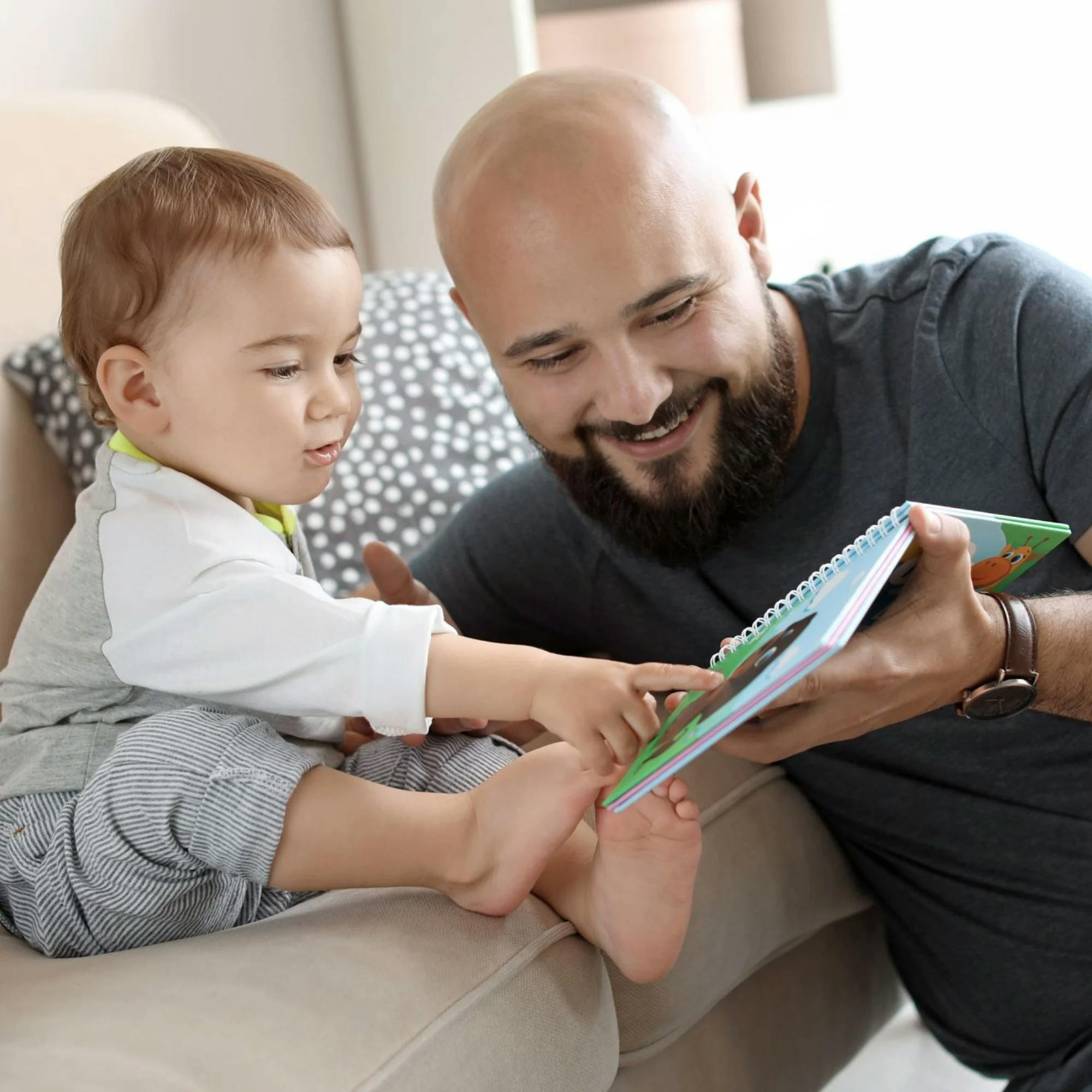Have you ever noticed how many children’s toys and books focus on animals, cars, trains, and other things that make sounds? There’s a reason for that. Kids love imitating sounds, and imitation is a major milestone in their speech and language development.
While meowing like a cat or vrooming like a car can feel like simple play, learning to make animal and vehicle sounds is a big step in a toddler’s expressive language skills. Read on to learn why–plus, get practical tips for teaching your child to imitate these fun sounds!
The importance of imitation in childhood development
Even before babies can say their first word, they are absorbing and learning the sounds and rules of our language. They do this by hearing people speak, playing with toys, listening to books read aloud, and interacting with their caregivers.
Babies and children learn to make sounds–and eventually, say words–by imitating what they hear. Imitation is when a person copies or repeats an action or sound. Research shows that the more often a parent participates in this type of back-and-forth exchange with their child, the stronger the response in the language parts of the baby’s brain. It’s a core part of their language growth, and it helps set the foundation for social skills, cognitive development, and more.
Babies learn to make sounds–and eventually, say words–by imitating what they hear.
Targeting animal sounds or other environmental sounds, like the sounds of planes, trains, or cars, is known as verbal imitation. But keep in mind, this is just one form of imitation. There are other types of imitation that babies and toddlers need to learn in order to be ready to talk. Gesture imitation and play-action imitation are a big part of childhood development. You can read more about them here. If your child isn’t quite ready to imitate sounds, try activities related to imitating gestures (such as clapping) or play actions (such as rolling a ball).
What are animal and environmental sounds?
Animal sounds are exactly what you’d think–sounds that animals make. Some common examples: Moo! Baa! Woof! Oink! Quack! Meow!
Environmental sounds are things you hear in the world around you, including vehicles. Examples include: Beep beep! Vroom! Choo choo! Ding! Weeee-oooo weee-ooo! Zoom! Ring ring!
Kids often gravitate toward animals and vehicles, which means toddlers are motivated to learn and imitate the sounds they make. Sounds like these can be easier–and more fun!–to repeat than traditional words. There is a good chance that these animal and environmental sounds will be some of the first intentional speech sounds you hear from your child, after cooing and babbling.
At what age can a baby start making animal noises?
Your baby can start learning different animal and environmental sounds from day one! Hearing their caregiver model language in any way is beneficial for babies. However, babies typically become more interested in these types of sounds at around 6 months. Your baby may try to imitate sounds as early as 9 months old, but it may be closer to 12 months before they do this consistently.
4 activities for teaching animal and environmental sounds
The key is to make these activities fun and engaging for your child. The more interested your toddler is, the more likely they’ll be to imitate what you’re saying.
Here are 4 simple, motivating ways to help your child learn new sounds:
1 Read books together
Books are an easy way to focus on sounds. These Baby Touch and Feel books are engaging for little ones, although you can use any books with pictures of the sounds you’re working on. Another option: My First Touch and Feel Animal and Things That Go cards feature single pictures that help your child focus on what you’re talking about.
2 Sing songs and play music
Music is always a good choice for teaching little ones early communication skills. Songs like The Wheels on the Bus and Old McDonald are a fun way to incorporate new sounds. You can also practice gesture imitation as you use the song’s hand motions together!
3 Notice what’s around you
When you’re out and about with your child, pay attention to things that you see or hear. If you’re on a walk and see a dog, you can talk about how the dog says “woof!” If you’re driving and see a construction site with a bulldozer, you can model a noise like “errrrr!” or “vrroooom!”
4 Use toys
Don’t forget about simple toys you likely have at home. Toy firetrucks, trains, and cars; a toy phone; stuffed animals; or a toy barn with animals all give you a chance to show your child how to make these noises. Check out this video from one of our speech therapists as she demonstrates all the fun ways to play with toy farm animals.
Tips for teaching your child sounds
Start by practicing sounds you think they’ll be most excited by. If your child is transfixed by trucks or trains, go with vehicles. If they love books with farm animals, focus on those.
Try to have your child really watch you as you say the sounds. Sit face-to-face, and point to your mouth as you model the sounds. This will direct your child to watch how your mouth moves.
Sit face-to-face, and point to your mouth as you model the sounds.
Your child will likely need lots of opportunities to hear the sounds before they begin imitating them. So make it a point to practice often! Even if your child isn’t imitating yet, they are learning what sound is associated with what animal or object, and how to repeat it. One day you may see it all click as your child imitates a sound for the first time!


What if my child isn’t imitating sounds?
As mentioned earlier, babies typically start imitating sounds between ages 9 and 12 months. If your child is not meeting communication milestones for their age, talk with their pediatrician. They may refer to you for a speech and language evaluation with a speech therapist. If there is any suspicion of a speech delay, it’s helpful to receive an evaluation as soon as possible so speech therapy can begin if needed.
In the evaluation, the speech therapist will assess and observe how your child communicates. If your child qualifies for speech therapy, the therapist will build a treatment plan with specific goals for your child. These goals will be targeted in speech therapy sessions, and your speech therapist will show you how to help your child practice throughout the week. After all, your child only spends a short amount of time with their speech therapist. Most of their communication interactions are with you.
Don’t hesitate to reach out if you think your child may need speech therapy. The faster kids get the support they need, the more quickly they can start making progress! Get matched with a speech therapist here, or take our free online screener to learn more about your child’s needs.
How Expressable Can Help
Concerned your child isn't reaching age-expected milestones? Looking for communication support from a professional? Expressable is a national online speech therapy practice serving children and adults. We treat all major areas of communication and feeding, offer flexible hours including evenings and weekends, and accept most major health insurance plans. We’re proud to have earned more than 3,000 5-star reviews from our clients (4.9/5 average).
Our therapy model is centered on parent and caregiver involvement. Research proves that empowering caregivers to participate in their loved one’s therapy leads to better outcomes. That’s why we combine live, 1-on-1 speech therapy with personalized education and home practice activities for faster progress.
Communication is more than words. It’s how we share how we feel and show who we are. We’re here to help you or your child do just that.

 Abby Barnes, M.S., CCC-SLP
Abby Barnes, M.S., CCC-SLP










